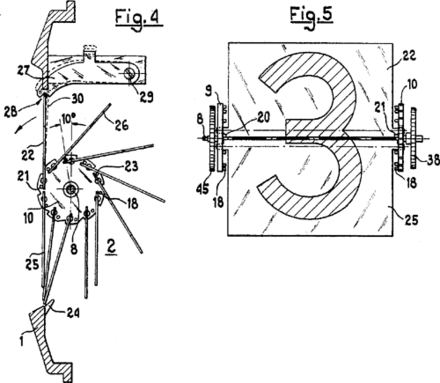Kenny Friedman, Week 01
I am proposing to make a split-flap display (see in the video below). They are the very cool, old style train station displays. They are beautiful, sound great, and are increasingly rare.
Here is a still-working split-flap display at the Frankfurt Airport:
There are very few working split flap displays left in this country, because bitmapped displays are far more practical. The obvious reason to have a split flap display is that they sound nice when they display an image, and they can look very pretty. There is one, very tiny minor advantage: there is a way to design the split flap display that once a message is presented, it can use very little (or possibly no) energy. Of course, e-ink displays also have this feature, and are bitmapped, so maybe there are no true engineering benefits.
A previous How To Make student, Anthony Kawecki, made a split flap display for his final project. The summer before he took this class, we actually spent a few weeks brainstorming how we could make a split-flap display (this was many years ago, and we both had much less experience). He took the class right after that summer, and made a very cool first display. I want to stand on the shoulders of his project by improving the design and adding some more 21st century elements to my display.
I want to have multiple characters possible to be displayed at the same time, and I want it connected to the internet, so "users" can communicate with it (by telling it what message to write, or implementing a call and response system).
A stretch goal would be to have each piece modular, so regardless of what order you arrange the letter-devices, it will figure out what order they are in by themselves, and display the proper message. Imagine the letters read "hello", and you swap the 'e' and 'o' letters, so it would spell "holle". I want the device to detect the re-arrangement, and turn each letter-device to once again spell the proper "hello" message.

There is a 1970 patent for a "Remote-controlled display device for selectively displaying signs or words".
Hardware Plan
I plan to laser cut the outer box of the display character, and 3d print the parts near the motor that need to be fabricated. I will use a servo or stepper motor to control the display, and I plan to use the vinyl cutter to print the actual characters that will go on the screen. Magnets on the sides of the letter will connect them to each other.
Software Plan
I believe I will only need ATtinys, or similar small micro-controllers. One for each letter. Each micro-controller will have the main function of setting the display to show a certain character. It will also communicate by receiving a partial message, displaying the first letter of the message, and then passing all the other letters down to the next character to be displayed.
Network Plan
Each character in the display will be networked together physically. When the magnets lock the characters into place, they will also connect the nodes that transfer data the nodes. Hopefully, the system will be as decentralized as possible, and any arrangement of the letters will automatically be detected and display the correct message.